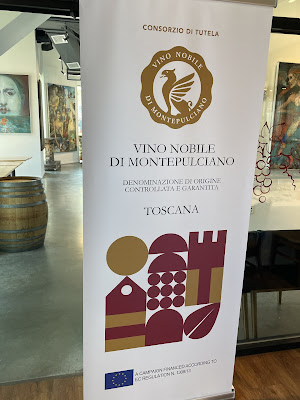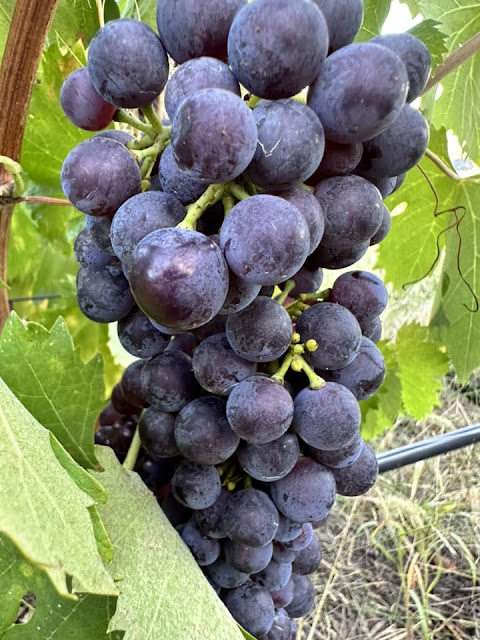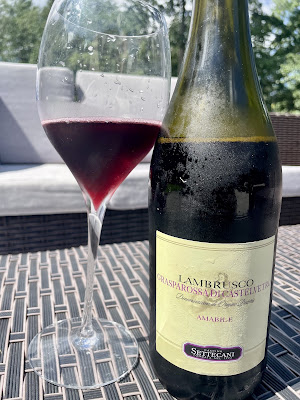Last month I featured Tuscany, but due to unforeseen circumstances I was unable to share my tasting in Boston that I attended at the Boston Winery on Vino Nobile di Montepulciano. The event was called Vino Nobile di Montepulciano: The History-Teller sponsored by the Consorzio di Vino Nobile di Montepulciano, promoted by IEEM, and led by Antonio Galloni, wine critic and owner of Vinous. We tasted an array of Vino Nobile di Montepulciano in a variety of styles, so I’ll highlight some of them here today.
 |
| Myself with Antonio Galloni |
Where is Montepulciano?
Montepulciano is a medieval town located in southeastern Tuscany between the Valdichiana and Val d’Orcia areas within the province of Siena.
 |
| Palazzo Comunale in Montepulciano |
The latest two projects of the Consorzio Vino Nobile di Montepulciano
The event was kicked off by Andrea Rossi, President of the Consorzio, who gave an overview of the Montepulciano territory and a couple of the projects that the Consorzio is engaged in at the time. One of these projects was the Equalitas standard’s sustainability certification that they have received, which took 10 years for them to obtain. They are the first and only, as of last year, Italian wine denomination to receive this certification. It’s an international forward-thinking organization that is for the wine sector that also certifies the region covering both Vino Nobile di Montepulciano DOCG vineyards and Rosso di Montalcino DOC vineyards. It has strict regulations at the environmental and socio-economic levels.
 |
| Left to right: Antonio, Andrea and Mariana (of IEEM) |
With the approval of the pieve will also be a change in the percentage of Sangiovese permitted. Currently Vino Nobile di Montepulciano must be a minimum of 70% Prugnolo Gentile, a clone of Sangiovese used in these wines. Moving forward for the pieve wines, the minimum requirement for Prugnolo Gentile will be 85% with up to 15% allowance of native grapes and no more allowance of international grapes. Antonio stated that times have changed, and the wines of Vino Nobile di Montepulciano are not about power. They are about finesse and elegance, which I experienced in several of the wines I tasted below.
The new Vino Nobile di Montepulciano Pieve
Here are the 12 pieve starting from the north: Ascianello, Badia, CAggiole and Gracciano. In the northeast is Cerliana and in the east is Valiano. In the southeast are the pieve of Argiano and Cervognano. West is the San Biagio pieve finishing in the south at Sant’Albino. The grapes will need to be controlled by the producer and grown in that pieve from vineyards that are a minimum of 15 years old. The wines will require a minimum of 3 years aging, like the current Vino Nobile di Montepulciano Riserva wines.
The Wines
Here is a list of some of the wonderful Vino Nobile di Montepulciano I had the opportunity to taste at the event. I’ll be highlighting about half of the list as they were some of my favorites.
- 2020 Fattoria della Talosa “Alboreto” VIno Nobile di Montepulciano DOCG
- 2020 Dei Vino Nobile di Montepulciano DOCG
- 2020 Poliziano “Asinone” Vino Nobile di Montepulciano DOCG Selezione
- 2020 Tenuta La Braccesca “La Braccesca” Vino Nobile di Montepulciano DOCG
- 2020 Tenuta Vadipiatta “Vigna d’Alfiero” Vino Nobile di Montepulciano DOCG Selezione
- 2020 Boscarelli Vino Nobile di Montepulciano DOCG
- 2019 Avignonesi Vino Nobile di Montepulciano DOCG
- 2020 Marchesi Frescobaldi “Tenuta Calimaia” Vino Nobile di Montepulciano DOCG
- 2020 Tenute del Cerro “Silineo” Vino Nobile di Montepulciano DOCG
- 2018 Montemercurio “Messaggero” Vino Nobile di Montepulciano DOCG
- 2018 Villa S. Anna Vino Nobile di Montepulciano DOCG

Fattoria della Talosa has been owned by Angelo Jacorossi since 1972. They own about 80 acres that sit at 1,100-1,300 feet above sea level. The wineries' old wine cellar, Talosa Cellar, dates to the 16th century and is located underground between 2 of the oldest town buildings, Palazzo Sinati and Palazzo Tarugi. The 2020 Fattoria della Talosa “Alboreto” VIno Nobile di Montepulciano DOCG I thought was a great introduction to Vino Nobile at a great price point to get familiarity with these wines. The wine is made from 100% Sangiovese. The wine was aged 2 years in tonneaux from 2nd, 3rd and 4th passage and 2 more months in stainless steel and large barrel. The wine spent a year in the bottle before release. It’s an approachable wine that is medium-bodied with bright acidity with vibrant cherry notes and elegant tannin through the lasting finish. ABV 14.5% SRP $22. The wine was suggested to pair with pici pasta and a tuscan ragu.
I also found the 2018 Villa S. Anna Vino Nobile di Montepulciano DOCG to be another classic expression of Vino Nobile di Montepulciano. Villa S. Anna is an all-woman owned and operated winery run by Simona Ruggeri Fabroni and her daughters Anna and Margherita. The estate has been around since the 1800’s, but this family started producing Vino Nobile in 1993. Prior to 1989 they sold off their grape juice in bulk. They own about 25 acres of vineyards in the village of Abbadia di Montepulciano. Their 2018 Vino Nobile di Montepulciano is made from 85% Sangiovese and 15% Mammolo Caniolo, Colorino and Merlot. The wine showed notes of dried cherries with some tobacco and licorice notes. A straightforward and rather delicate, but still enjoyable. ABV 13$ SRP $22. It’s recommended to pair this wine with traditional Tuscan dishes, game, venison, seasoned cheese and red meat.
Cantine Dei is a winery I’ve written about when I first started my blog. The winery is located on the east side of Montepulciano and began in 1964 when Alibrando Dei planted the 1st vineyard on the Bossona land. In the 70’s the family expanded their land and released their 1st Vino Nobile di Montepulciano in 1985. Today the winery is run by the granddaughter, Caterina Dei, who is also a musician. The 2020 Dei Vino Nobile di Montepulciano DOCG is made from 90% Sangiovese and 10% Canaiolo that lends brighter red fruit to the blend. The aromas were richer compared to the last with aromas of cherry, raspberries and plums. This wine spends at least 24 months aging with a minimum of 18 months in matured wood. Medium-bodied with tannins that were firm to start but developed to be silkier in the glass as it sat. Rich cherry notes with chocolate and spices. This wine also had a more developed texture than the last as well. ABV 14.5% SRP $36-40. This wine was suggested to pair with braised cheek with mashed potatoes.
Next was the 2020 Poliziano “Asinone” Vino Nobile di Montepulciano Selezione DOCG. I’ve had the privilege to visit Poliziano and taste a number of their wines well before my blogging days. The winery was founded in 1961 by Dino Carletti initially with 54 acres and has grown to over 640 acres under the son, Federico. This wine, “Asinone”, comes from one of their single vineyards that contributes to a more complex wine. Made from 100% Sangiovese, this wine spends 16-18 months in Tonneaux, partly new and part second passage. Medium-bodied with lively acidity. This wine has a beautiful balance with notes of cherry and cocoa with vanilla showing up on the finish that is lengthy finishing with a touch of minerality. ABV 14% SRP $65. It’s suggested to pair this wine with Bistecca alla Fiorentina.
Avignonesi is currently owned by Virginie Saverys since 2009. She’s a Belgium native who came from a career in law but had the dream and opportunity to move to Tuscany and acquire Avignonesi. She has a strong belief in sustainability and is one of the largest biodynamic wineries in Italy. Her aim is produce wines that limit the usage of oak to produce wines that are fresher displaying fruit with vibrant acidity. Avignonesi owns over 430 acres with plots of land that are all vinified separately before coming together for final blends. The 2019 Avignonesi Vino Nobile di Montepulciano DOCG is made from 100% Sangiovese aged at least 18 months in Slavonian oak barrels, oak barriques and tonneaux with at least 6 months in the bottle. Fresh, sweet berries on the nose of cherries and strawberries. As Antonio described this wine best it has “an intensity without the weight”. It felt airy on the palate with a beautiful balance and elegance that showed the purity of fruit of ripe cherries. A harmonious wine. ABV 13.5% SRP $28. It’s suggested to pair this wine with traditional dishes to include prosciutto, pasta, pizza and pecorino.
Lastly was the 2018 Montemercurio Vino Nobile di Montepulciano “Messaggero” DOCG. Montemercurio was described by Antonio as an “elite artisan estate” with a smaller production. The grandfather, Damo, planted the vineyards in the 60’s with an original 7.5 aces. Unfortunately, Damo passed away in 2005, but his family took over established the winery in 2007 and expanded the acreage to about 25 acres selling their first bottle of Vino Nobile in 2011. Today the winery is led today by Marco today along with the help of his father Maurizio. The 2018 Vino Nobile is made of 95% Sangiovese and 5% Canaiolo Nero. It’s aged for 18 months in 40 hl Slovenian oak and 6 months in 10 hl oak.
Have you visited this area and what are you some of your favorite producers of Vino Nobile di Montepulciano?
You can find other Vino Nobile di Montepulciano wines on Wine.com.





